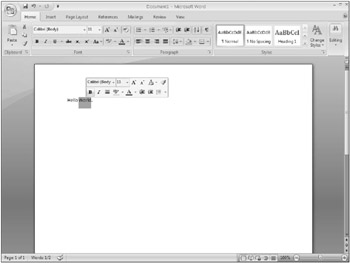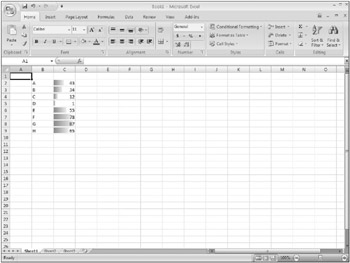The Microsoft Office System
Along with Windows, Office has defined Microsoft for many years. Originally, the components of Office were available for purchase separately; then someone had the bright idea to package these applications together as a productivity suite. This launched one of the most successful software mainstays in the history of computing.
Over the years, Microsoft has continued to improve upon the software by offering feature upgrades and occasionally new components. Because Office has generally met people’s needs fairly well, the argument to upgrade to the next version needed to be compelling. Adding a few more fancy features in Word doesn’t make it worth the several-hundred-dollars-per-user investment.
The Office 2007 system offers lots of new functionality. The most obvious changes from an end-user perspective are the differences in the user interface. Most of the Office 2007 applications use a replacement for standard menus called the ribbon. The ribbon is meant to easily expose common tasks in a context-sensitive manner. For example, if a user is working with tables, the ribbon tries to figure this out and presents the user with a common set of tasks for editing tables.
The Usual Suspects
Before digging into workflow and Office too deeply, it wouldn’t hurt to refamiliarize yourself with the standard pieces of the Office system that have made the software so famous over the years. What says “Office” better than Microsoft Word? Figure 15-1 is a screen shot of Word 2007 that showcases a couple of the new features, such as the ribbon and the mini-toolbar for formatting changes inline with text.

Figure 15-1
Of course, Microsoft Excel is also back with some new features. Along with the new ribbon interface, Excel sports some great new data visualization features. For example, Figure 15-2 showcases a conditional formatting option called data bars that displays a cell’s numeric value by shading a portion of the cell with a chosen color. Other new features include enhanced connectivity to data sources such as SQL Server databases and SQL Server Analysis Services cubes for live analysis. The charting capabilities in Excel have also been greatly enhanced to allow more professional-looking graphics.

Figure 15-2
The rest of the standard applications - such as Outlook, PowerPoint, Publisher, and Access - are still around in Office 2007, of course. Furthermore, the relatively new, but still updated for 2007, applications such as OneNote and InfoPath can be included in the suite.
New Kids on the Block
Several new applications are included in the Office suite, most of which are on the server. Forms Server greatly expands the possibilities for the InfoPath platform. Although InfoPath is a great tool for creating reusable forms that connect to various back-end systems, it was limited in that users were forced to have the InfoPath client installed on their machines. Forms Server has now gotten rid of this requirement by providing a server-side rendering engine for forms that were authored in the InfoPath client. This allows forms to be viewed and filled out in a standard web browser. Although the number of users that can utilize forms grows with the server-based architecture, it comes with the price of decreased functionality. The browser can be pushed only so far compared with a custom-built client application. (InfoPath and Forms Server are discussed in more detail later in this chapter.)
Excel Services is another server-based product that is related to a client application: Excel, of course. By calculating and rendering spreadsheets on the server, Excel Services provides a few benefits. First, spreadsheets are viewable by users who do not have Excel installed on their workstations. Additionally, when spreadsheets that are important to business processes are stored on the server instead of on multiple users’ desktops, there is one version of the truth that can be accessed and modified by different people. Another advantage of the server-based engine is that complex Excel spreadsheets, which may take long to calculate on a workstation, can be offloaded to a more powerful back-end machine.
There are a few other new components in the Office 2007 lineup, including Microsoft Office Groove, which is a virtual-office tool that allows real-time collaboration of distributed teams working on a common project, as well as Microsoft Office SharePoint designer, which is discussed later in this chapter as it relates to workflow development on the Office platform.
SharePoint
SharePoint, Microsoft’s answer to the enterprise portal, has quickly grown up since its introduction in 2001. The main selling point for a server-based portal product such as SharePoint is increased collaboration throughout departments and the enterprise. Collaboration is enabled through the use of document libraries, online calendars, announcements, alerts, and many more features. In addition, SharePoint has an extensible programming infrastructure that uses a concept called web parts. Web parts are reusable widgets that can be placed in any SharePoint page and configured however the developer specifies.
Pretty much everything in SharePoint is a list. A list is what you think it would be: a collection of items. Documents are the items that live in a document library; events live in a calendar; issues live in an issue tracker list; and so on. This architecture makes for a very extensible platform that can handle new types of user-created items.
In Office 2003, SharePoint and Office were integrated to the point that users could open documents directly from SharePoint, and the client applications were aware of the server-based locations of the documents. This allowed users to check in and check out documents from document libraries from within Word, Excel, and other Office applications. Office 2007 enhances this integration, especially as it relates to workflows. The Microsoft Office applications are aware of workflows running against a given document and allow the user to interact with the workflow through context-specific buttons and forms. This functionality is discussed later in this chapter.
There are many new features in SharePoint 2007 compared with SharePoint 2003. A short list includes the following items:
-
ASP.NET 2.0 web part infrastructure
-
Blogs
-
Wikis
-
Recycle Bin
-
Spell check
-
Lists exposed as Really Simple Syndication (RSS)
-
Item-level security
-
Business Data Catalog
-
Enhanced mobile device support
-
PowerPoint slide libraries
-
Forms authentication
SharePoint Flavors
There are two distinctly different versions of SharePoint in the 2007 release: Windows SharePoint Services and Microsoft Office SharePoint Server.
Windows SharePoint Services
Windows SharePoint Services (WSS) version 3 is an updated version of the web-based portal software from 2003. One of the best features of WSS, aside from all the great collaboration tools, is the fact that it is completely free - at least free with the purchase of a Windows Server operating system license. WSS is included with Windows Server as an option, just like IIS or other optional components.
Microsoft Office SharePoint Server
Microsoft Office SharePoint Server (MOSS) is comparable to the nonfree SharePoint Portal Server (SPS) from 2003. It includes many enterprise-level features that are not included in its free counterpart, such as the use of Forms Server.
The SharePoint Web Services
Like SharePoint in 2003, SharePoint in 2007 exposes an API through a set of web services. The API allows interaction with the workflow functionality built into SharePoint. Actions such as obtaining information about running workflows, starting new workflow instances, and completing workflow-related tasks can be performed using the web services.
EAN: 2147483647
Pages: 118